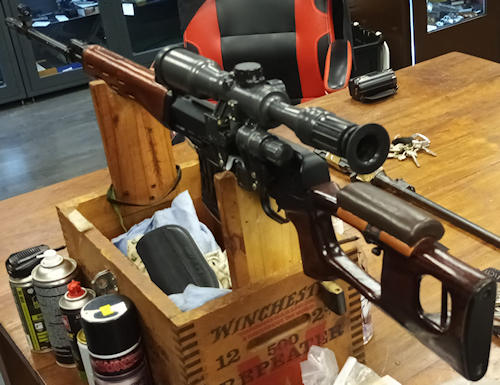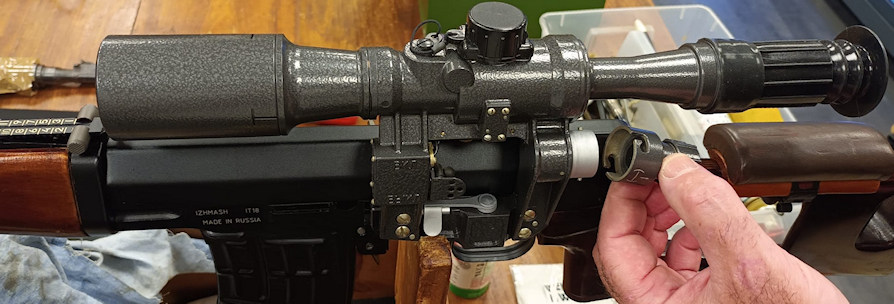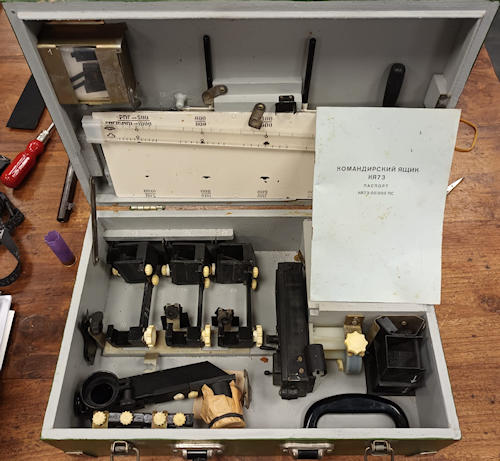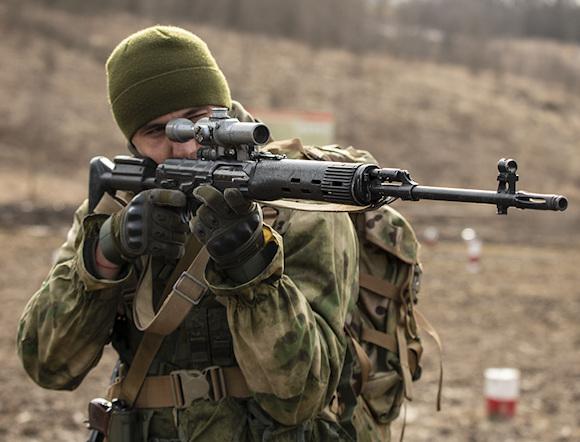It is, by far, the most used "marksman" rifle by women OpFor (a term used within NATO to generically indicate the forces, regular and otherwise, opposed to Western armies).
SVD (Snayperskaya Vintovka Dragunova) is the Russian acronym for "Dragunov Sniper Rifle". It is a semi-automatic weapon system in 7.62x54 R caliber (Russian), which entered service in 1963, initially optimized only for anti-personnel shooting up to (almost) 1000 metres.
In the mid-70s the rifling pitch of the barrel underwent a revision, which went from 240 to 320mm, in order to also be able to use armor-piercing and incendiary ammunition, therefore also for anti-material use, which gave rise to a loss of precision beyond 500 meters estimated at around 20%, also given the necessarily lighter weight of the bullets.
We can say that its rivals were the semi-automatic M14 USA, the various European "precise" versions of the FAL FN, the Finnish SAKO VALMET M88, the German HK G3, and others, in 7.62x51 caliber.
The design and ergonomics are reminiscent of the AK 47, with the forend above the barrel, but the similarity ends there. The mechanics include a short-stroke piston, with a sliding shutter that does not rotate as in the Kalashnikov, which is inspired by the Garand M1.

We can state that the geometric linearity (barrel-stock) of the project recalls the FAL FN, with a fairly thin barrel and a flame arrester very similar to the Belgian rifle, with another similarity represented by the possibility of regulating the gas on 3 positions, up to closure, which allows both the throwing of bombs (type Energize) and, more peculiarly, the single shot with manual shutter cocking.
Gas regulation is also fundamental for a weapon whose use is expected at temperatures ranging from -50 to +50 degrees and occurs simply by using a cartridge from the same rifle.
The iron sights remain, although I think they are rarely used.
If at first contact you cannot help but notice the somewhat rough workmanship of the case and levers, obtained by moulding, it should always be kept in mind that the tolerances are designed based on even significant changes in temperature: AK47 doc.
I had the opportunity to try (only "in white" unfortunately) a splendid model Izmash, still with wooden stock, and I must say that I didn't feel very comfortable in the sling, given the lack of adjustment, given by the wood which simulates the first versions. The most modern ones have polymer stocks, adjustable, and thus adaptable to the shooter's needs.

The scope, an NPZ PO6x36 produced exclusively for the Dragunov which is placed to the left of the weapon's axis, with dedicated slides, is very bright in its essentiality, with the typical Russian reticle, in this case intended for the use of a very interesting "silent" resetting system.

With the application of special, graduated lenses and a mechanical ballistic calculation system, the shooter could have a fairly precise ballistic table (it is said).
Very pragmatically, any type of night vision was excluded, while maintaining the backlighting through a simple penlight battery.
Bottom line: the SVD Dragunov, even today, is a more than honest weapon system that does its job well. The 7.62x54 R cartridge is designed exactly to go "a little further" than the 7.62x51 NATO, which it does without too many problems.
As I have already way of writing, in the "right" (or wrong) hands, was and will still be a formidable enemy. And this should be explained well to our patrols and escorts on duty in the hot areas of the planet.
Small parenthesis: the fact that we are considering semi-automatic rifles equipped with optics, assigned yesterday to "marksman" shooters of the light infantry platoons of both the NATO and WARSAW PACT armies, and today everywhere in the world, reopens a rather painful wound for me, thinking back to the infantry platoons of the EI which only towards the end of the 80s (and unfortunately well after) saw the arrival of some sniper rifles in the armories of the operational battalions and regiments. This is thanks to the courage and professionalism of some officers who, in the field, understood at their own expense how valuable it was to be able to have an interdiction and/or support shot, at distances double and triple the normal range of action of the rifles then standard in the Italian infantry.
Hoping, or waiting, to be able to have special forces assets available for anti-sniper shooting was a shameful thing, allow me to say, towards the soldiers (often conscripts!) sent into combat (and not in hypocritical "peace mission") in many parts of the world where it was well known that the enemy could have rifles like the DRAGUNOV at their disposal. Leaving aside, for goodness sake, the discussion on the necessary training...
I repeat: a shame!
Closed brackets.
(Online Defense thanks the ARMERIA DE GRADI of CORSICO - MILAN)
Photo: MoD Russian Fed. / author












